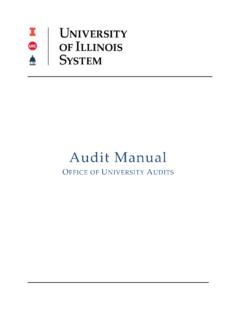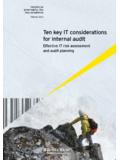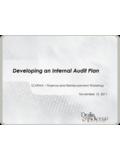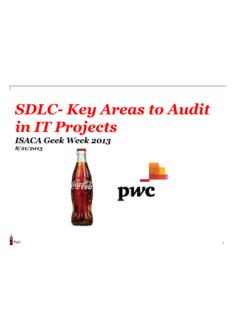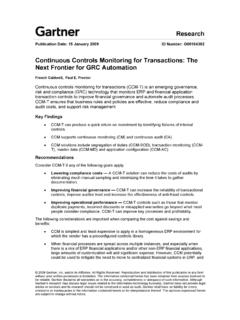Transcription of Internal Control Concepts and Applications for Business ...
1 Internal Control Concepts and Applications for Business Operationsat the University of IllinoisCarla Jones and Teri TravisOffice of University AuditsMarch 9, 2015 What is Internal Control ? A processwithin an organization designed to provide reasonable assurance: That information is reliable, accurate, and timely. Of compliancewith policies, plans, procedures, laws, regulations, and contracts. That assets (including people) are safeguarded. Of the most effective, economical, and efficientuse of resources. That overall established objectives and goals are met. Intended to prevent errors or irregularities, identify problems, and ensure that corrective action is taken. Internal controls may be: Preventive, Detective, Corrective, Directive 2 Key Internal Control Concepts : Not static Effected by people Objective is reasonableassurance Applicability: Financial and administrative processes Operational processes Compliance processes Governance processes3 Internal Controls May Be.
2 Preventive stops something from happening Detective finds out what happened, alerts you as it happens or shortly after Corrective follow detective controls, recovery from consequences of an error or unexpected event Directive tells folks what should happen4 Preventive Controls Security Access Segregation of duties Physical controls over assets Authorized signers University payables review and approval of travel vouchers prior to processing Reminders of policies, procedures, and expectationsDetective Controls Banner account reconciliations Management review of reconciliations Physical inventories P-Card logging, reconciliation, and approval Review of budget to actual Year to year expenditure trending Internal auditorsCorrective Controls Error communication and reporting Documentation systems or processes Improvement initiatives Discipline actionsDirective Controls University of Illinois Statutes OBFS policies and procedures Campus Administrative Manual College policies Unit procedures5 Who s Responsible?
3 ?? Board of Trustees President Line Management Frontline Personnel Internal AuditUniversity policy establishes some responsibilities for the Internal Control system to all University employees. Internal Control gets us where we want to go, without surprises along the way. Internal Control is everyone s Internal Control is me. - From a Cargill Corporation presentation6 Internal Control Pyramid7 Risk Assessment Identification of risk factors with regard to objectives External factors ( , economic factors, rules, regulations) Internal factors ( , new personnel, low morale) Risk Analysis Estimate significance of the risk Estimate likelihood of occurrence Manage Risks: Assessing options for controls Differing types of controls ( , preventive, detective, etc.)
4 Resource availability Cost / Benefit8 Control Activities Documentation, Approval, Authorization, Verification Segregation of duties Top level performance monitoring Performance Indicators Supervision: Direct functional or activity management Information processing Safeguarding Assets: Physical controls9 Limitations Judgment (Human error) Breakdowns Misunderstandings Carelessness Distraction Reliance on person instead of process Management override Collusion Dishonesty Cost versus benefits10 Most Common Control Weaknesses Segregation of duties Reconciliations Completeness Competent and knowledgeably placed staff Adequate documentation supporting transactionsand/or decisions Compliance with University policies for spending basedon fund or funds purpose11 What is the Control Environment?
5 Personal and professional integrity Values and ethicsof management and staff Established at all levelsof an organization Official communication on compliance and individual responsibility Management s actions related to gathering facts and giving advice Importance placed on approvals and actions Tolerance (or lack thereof) for circumvention of controls or departmental staff positioned to provide controls Public and private responses to official communications and/or individuals on policies, Control activities, and guidance from above Commentary around the table Responses to problems, abuse, misuse, or violations of expectations12 Tips for Success Prioritize training At all levels, including taking advantage of opportunities for faculty training Consider subject matter and frequency Refreshers are a good thing Embrace and aggressively use of data analysis and reporting tools ( , E D W, Webi)
6 Network of advisory resources with varied participants Seek advice and perspectives and create a culture of asking questions Encourage confidence (at all levels) to challenge decisions or actions ( , incorrect, unethical, inefficient) and accept feedback on decisions with open minds Carefully and selectively delegate roles to ensure a balanced handle on the forest and the trees Recognize the importance of the Control environment Perform little re-assessments regularly13 Key Internal Control PointsControl PointsSuggestionsSelf Supporting Activities Adequate rate consideration Review of and supporting analyses for rate or fee structures Consistency in applying rates and discounts Awarenessof subsidies Monitoring or quantification of subsidies Appropriate classification of activities Expenses directly related to the revenue-generating activity Use of contracts when required Related.
7 Storeroom Management Purchasing, Inventory, Reconciliations Work with Governmental Costing to determine if rates assessed are appropriate Document basis for rates Review actual nature of activity vsbusiness purpose / mission Perform annual fund balance analyses; review and address deficits or overages outside of tolerance Review customer makeup external vs. Internal is the fund type appropriate (3E vs 3Q)? Work with UAFR if this is in question Review nature of costs charged to the fund Complete? Appropriate? Completeness controls over billing Are appropriate inventory management procedures and reconciliations in place? FollowLAC guidelines14 Key Internal Control PointsControl PointsSuggestionsDeficit Monitoring and Reduction Planning Formal plan for reduction Appropriate approval for a plan Adequately addressdeficit elimination.
8 Actionable Implement appropriate monitoring of allunit funds to ensure timely detection or prediction of deficits Work with the department head and/or college and/or provost budget office to develop a deficit reduction plan Timely and regular monitoring of progress against the planGifts Compliance with gift agreement terms Donor Intent Board of Trustee established requirements Review gift agreement terms on an annual basis against original documents, not Internal notes Develop and maintain a guide for intended use of departmentally controlled gift funds which is accessible to Business staff as well as faculty Obtain UIF reports on gift fund accumulations and establish a plan to use or reinvest them Gifts from faculty should not be deposited into funds which support his/her own program unless Control of the funds issegregated15 Key Internal Control PointsControl PointsSuggestionsConflict of Interest and/or Commitment Appropriate Review No Delegation(not permitted)
9 Documentation of conclusions or additionalinformation gathering Reference to existing management plans Appropriate Processing All required employees completed a form Joint appointment issues addressed in approval process and routing Management plans/committees are active and functioning Illinois Procurement Code Other Conflicts Nepotism, personal relationships Regular staff meetings for awareness, education, and reminders ( , contract policies, conflict of interest, receipts, use of University resources) Seek advice from the Associate Vice Chancellor for Research re: faculty conflicts Unit head / director must review andapprove all delegation is not permissible Develop mechanisms (calendar / task reminders, etc) to ensure management plans are functional Integrate information into ongoingdepartmental processes such as purchasing, grant administration16 Key Internal Control PointsControl PointsSuggestionsInformation Security Account Access Reviews Data Classification Security Incident Procedures Security awareness training for staff Business Continuity planning Data backup Establish procedures to periodically review and adjust, user access to systems ( , Banner, EDDIE, college and unit systems and resources).
10 Establish procedures to revoke user access to systems when individuals leave your unit Meet with operational and IT personnel to identify High Risk and Sensitive information ( , SSN, FERPA, HIPAA, PCI, Federal restrictions, PIPA, Banking) Develop and communicate a plan for security incidents Meet with operationaland IT personnel to discuss the policies for handling High Risk and Sensitive information Develop, and periodically test and update a plan appropriate to your unit Establish off-site backup at a frequencyappropriate and adequate for operational needs17 Key Internal Control PointsControl PointsSuggestionsPCard/ TCard Documented Business purpose Documentedtransaction support No personal expenditures Independent reconciliation With original receipts With travel voucher Attention to the big picture Do we have the right amount of PCardorTCardvolume given other, better controlled, procurement options?
